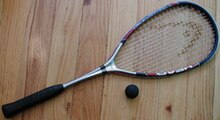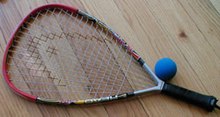Our website is made possible by displaying online advertisements to our visitors.
Please consider supporting us by disabling your ad blocker.
Racket (sports equipment)


A racket or racquet[1] is an item of sporting equipment used to strike a ball or shuttlecock in a variety of sports. A racket consists of three major components: a widened distal end known as the head, an elongated handle known as the grip, and a reinforced connection between the head and handle known as the throat or heart. The head of the racket forms a flattened firm surface, known as the face, which is used to strike the ball or shuttlecock.
In the strictest sense, the word "racket" specifically refers to a striking implement with a mesh face made of interlaced, tightly stretched strings fixed on an ovoid frame known as the rim. This type of racket is used in sports such as tennis, badminton, and racquetball. Some rackets have a rigid one-piece head with a solid or fenestrated face instead of a meshwork of strings. Such rackets are called a paddle or bat, and are used in sports such as table tennis, pickleball and padel. Collectively, sporting games using rackets and paddles are all known as racket sports[citation needed].
Racket design, materials and manufacturing has changed considerably over the centuries.[2] The frame of rackets for all sports was traditionally made of solid wood (later laminated wood) and the strings of animal intestine known as catgut. The traditional racket size was limited by the strength and weight of the wooden frame which had to be strong enough to hold the strings and stiff enough to hit the ball or shuttle. Manufacturers started adding non-wood laminates to wood rackets to improve stiffness. Non-wood rackets were made first of steel, then of aluminum, and then carbon fiber composites. Wood is still used for real tennis, rackets, and xare. Most rackets are now made of composite materials including carbon fiber or fiberglass, metals such as titanium alloys, or ceramics.
Catgut has partially been replaced by synthetic materials including nylon, polyamide, and other polymers. Rackets are restrung when necessary, which may be after every match for a professional. Despite the name, "catgut" has never been made from any part of a cat.
- ^ "Racket vs. racquet". Grammarist. February 2011. Retrieved 5 September 2012.
- ^ Taraborrelli, Luca; Grant, Robyn; Sullivan, Matthew; Choppin, Simon; Spurr, James; Haake, Steve; Allen, Tom (17 October 2019). "Materials Have Driven the Historical Development of the Tennis Racket" (PDF). Applied Sciences. 9 (20): 4352. doi:10.3390/app9204352.
Previous Page Next Page


